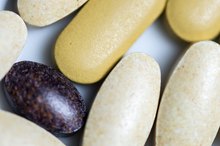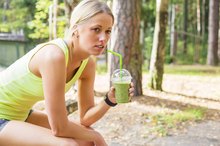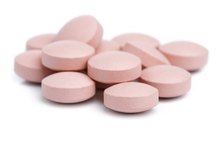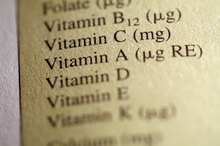What does fact checked mean?
At Healthfully, we strive to deliver objective content that is accurate and up-to-date. Our team periodically reviews articles in order to ensure content quality. The sources cited below consist of evidence from peer-reviewed journals, prominent medical organizations, academic associations, and government data.
- Linus Pauling Institute: Vitamin C
- Linus Pauling Institute: Vitamins E and C and the Recovery From Anterior Cruciate Ligament Surgery
The information contained on this site is for informational purposes only, and should not be used as a substitute for the advice of a professional health care provider. Please check with the appropriate physician regarding health questions and concerns. Although we strive to deliver accurate and up-to-date information, no guarantee to that effect is made.
Vitamins for Torn Muscles & Ligaments
Muscles and ligaments provide support for your skeleton, and the function of these tissues is essential for proper posture, physical activity and locomotion. Muscle tissue and ligaments contain specialized molecules that provide the tissues with strength, as well as allow for proper muscle contraction. Some essential vitamins obtained from your diet aid in the maintenance of ligaments and muscle tissue, and adequate consumption of these vitamins may aid in muscle and ligament repair.
Vitamin C
One vitamin that can aid in the repair of torn muscles and ligaments is vitamin C. This vitamin aids in the repair of these tissues through its role in synthesizing collagen, a protein found in both muscles and connective tissue. Collagen provides structural support for muscles and ligament fibers, increasing the strength of the tissue. The Linus Pauling Institutes indicates that vitamin C plays an essential role in collagen synthesis, with deficiencies in the vitamin leading to symptoms in collagen-rich tissues 1. Consuming adequate levels of vitamin C, either through dietary supplements or ingesting foods rich in vitamin C like citrus fruits, can help support normal collagen synthesis and facilitate muscle and tendon repair.
- One vitamin that can aid in the repair of torn muscles and ligaments is vitamin C. This vitamin aids in the repair of these tissues through its role in synthesizing collagen, a protein found in both muscles and connective tissue.
- Consuming adequate levels of vitamin C, either through dietary supplements or ingesting foods rich in vitamin C like citrus fruits, can help support normal collagen synthesis and facilitate muscle and tendon repair.
Vitamin E
Vitamins for Ligament Repair
Learn More
Vitamin E may also aid in muscle and ligament repair. The family of eight compounds that are collectively referred to as vitamin E play a role in regulating inflammation, your body's response to injury that helps promote proper healing. Upon tissue damage, including muscle and ligament damage, your body secretes pro-inflammatory factors called cytokines, which recruit cells to repair damaged tissue. The Linus Pauling Institute indicates that vitamin E plays a role in regulating the release of these cytokines, and indicates that this regulation plays a role in speeding healing after surgery to the anterior cruciate ligament 12. Consuming foods that contain vitamin E, including corn, soybean or olive oils, may help promote proper muscle and ligament healing.
- Vitamin E may also aid in muscle and ligament repair.
- Consuming foods that contain vitamin E, including corn, soybean or olive oils, may help promote proper muscle and ligament healing.
Vitamin B12
Another vitamin that may aid in muscle and ligament healing is vitamin B12. This vitamin belongs to the family of B-class vitamins, which aid in metabolizing the nutrients you eat into chemicals that can be used in your cells, explains the University of Maryland Medical Center 3. Specifically, vitamin B12 aids in the breakdown of dietary proteins into amino acids, which are then reused and made into human protein. This dietary protein breakdown aids muscle and tissue repair, since the healing process involves the production of new muscle and ligament proteins, which contribute to the newly formed tissue. Without the presence of vitamin B12 the inefficient breakdown of proteins would hinder your body's ability to generate new proteins and tissue for muscles and ligaments, slowing the healing process. Foods such as meats and dairy products serve as source of vitamin B12, and eating these foods may help support recovery after a muscle or ligament injury.
- Another vitamin that may aid in muscle and ligament healing is vitamin B12.
- Specifically, vitamin B12 aids in the breakdown of dietary proteins into amino acids, which are then reused and made into human protein.
Related Articles
References
- Linus Pauling Institute: Vitamin C
- Linus Pauling Institute: Vitamins E and C and the Recovery From Anterior Cruciate Ligament Surgery
- University of Maryland Medical Center: Vitamin B12 (Cobalmin)
- Davey, M. W., Montagu, M. V., Inzé, D., Sanmartin, M., Kanellis, A., Smirnoff, N., ... & Fletcher, J. (2000). Plant Lâascorbic acid: chemistry, function, metabolism, bioavailability and effects of processing. Journal of the Science of Food and Agriculture, 80(7), 825-860.
- Alessio, H. M., Hagerman, A. E., Fulkerson, B. K., Ambrose, J. E. S. S. I. C. A., Rice, R. E., & Wiley, R. L. (2000). Generation of reactive oxygen species after exhaustive aerobic and isometric exercise. Medicine and Science in Sports and Exercise, 32(9), 1576-1581.
- Padayatty, S. J., Katz, A., Wang, Y., Eck, P., Kwon, O., Lee, J. H., ... & Levine, M. (2003). Vitamin C as an antioxidant: evaluation of its role in disease prevention. Journal of the American College of Nutrition, 22(1), 18-35.
- Bendich, A., & Langseth, L. (1995). The health effects of vitamin C supplementation: a review. Journal of the American College of Nutrition, 14(2), 124-136.
- Douglas, R. M., & Hemilä, H. (2005). Vitamin C for preventing and treating the common cold. PLoS Medicine, 2(6), e168.
- Bryer, S. C., & Goldfarb, A. H. (2006). Effect of high dose vitamin C supplementation on muscle soreness, damage, function, and oxidative stress to eccentric exercise. International Journal of Sport Nutrition and Exercise Metabolism, 16(3), 270-280.
- Nakhostin-Roohi, B., Babaei, P., Rahmani-Nia, F., & Bohlooli, S. (2008). Effect of vitamin C supplementation on lipid peroxidation, muscle damage and inflammation after 30-min exercise at 75% VO^ sub 2max^. Journal of Sports Medicine and Physical Fitness, 48(2), 217.
- Li, H., Zou, Y., & Ding, G. (2012). Dietary factors associated with dental erosion: a meta-analysis. PloS One, 7(8), e42626.
- Moertel, C. G., Fleming, T. R., Creagan, E. T., Rubin, J., O'Connell, M. J., & Ames, M. M. (1985). High-dose vitamin C versus placebo in the treatment of patients with advanced cancer who have had no prior chemotherapy: a randomized double-blind comparison. New England Journal of Medicine, 312(3), 137-141.
- Bruno, R. S., Leonard, S. W., Atkinson, J., Montine, T. J., Ramakrishnan, R., Bray, T. M., & Traber, M. G. (2006). Faster plasma vitamin E disappearance in smokers is normalized by vitamin C supplementation. Free Radical Biology and Medicine, 40(4), 689-697. .
- Huang, J., & May, J. M. (2003). Ascorbic acid spares α-tocopherol and prevents lipid peroxidation in cultured H4IIE liver cells. Molecular and Cellular Biochemistry, 247(1), 171-176.
- Kalgaonkar, S., & Lönnerdal, B. (2008). Effects of dietary factors on iron uptake from ferritin by Caco-2 cells. The Journal of Nutritional Biochemistry, 19(1), 33-39.
- Monsen, E. R. (2000). Dietary reference intakes for the antioxidant nutrients: vitamin C, vitamin E, selenium, and carotenoids. Journal of the American Dietetic Association, 100(6), 637-640.
Writer Bio
Sylvie Tremblay holds a Master of Science in molecular and cellular biology and has years of experience as a cancer researcher and neuroscientist.








